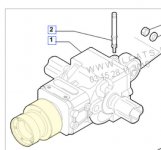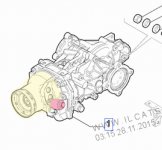Edit: And Herts Hillhopper jumps in to the rescue. I'll keep the text below as a simple explainer for mechanical viscous couplings and Haldex electronically controlled viscous couplings, but the information may not actually pertain to the system available in the Panda 4x4.
From what I understand, the Fiat system is an electronically controlled viscous coupling "center" differential. Basically, the gearbox output shaft is attached to an "open" differential at the front axle, along with the driveshaft running down the centerline of the underside of the car into a viscous coupling housed between the two rear wheels. The final drive from the gearbox is therefore always spinning the driveshaft, and if all the wheels are rotating at the same speed, the clutch plates in the viscous coupling are also rotating at the same speed. That means the fluid between the clutch plates in that coupling is at a "viscous" temperature and it retains fluidity.
The actual method of providing drive, however, occurs on two fronts. The first is when the wheel speeds of the two axles differ. Under normal driving conditions, that 2% quoted power to the rear is most likely a result of the driveshaft providing a small amount of input torque to the viscous coupling. When, however, the front wheels slip, this creates a speed difference between the speed of the front axles and driveshaft, and the output shaft of the viscous coupling (and therefore a speed difference between the clutch plates). Unlike regular clutch plates, these plates have holes in them to allow the fluid to run through all of them. When, however, the plates start turning at different speeds, this creates friction in both the fluid and between the plates. The whole point of the viscous fluid in the system is that it loses fluidity as temperature increases. Basically it's the exact opposite of how cooling water to make ice works. Imagine an absurd universe in which the more you heat water, the harder it gets, going through phases such as "fluid", "pudding", "cake dough", cookie dough", "hard biscuit dough", "inedible rock". As the heat builds, the viscous fluid loses viscosity becoming harder, and since it runs through all the clutch plates, it starts forcing them to turn at the same speed. Eventually, if it heats up enough, it will become essentially solid, forcing the front and rear axles to turn at the same speed. How fast all this happens depends on the design of the viscous coupling, along with the properties of the fluid used (such as how fast it hardens under how much heat, how fluid it is to begin with etc).
At the rear axle, from what I can tell, there is another open differential after the viscous coupling that splits whatever power that makes it through the coupling between the two rear wheels.
The above explanation is the mechanical aspect of it, but there's also the second portion of the system: the electronics.
Different sources provide different explanations on the electronics of the Panda 4x4 system, with the most important variation existing on an explanation of the ELD system. As such, the explanation below is my best approximation based on the information available.
In addition to the mechanical method of splitting torque between the front and rear axles, as with most modern cars, the Panda 4x4 has ABS and all the associated electronic sensors. As such, it utilizes the wheel speed sensors of the ABS system to sense when one or more wheels aren't rotating at the speed they should be. Modern electronic stability systems use this information to keep the car "stable" during driving, by using the brakes to slow down certain wheels in an attempt to prevent the vehicle from rotating beyond the limits of grip. As such, when wheel speed sensor information indicates that the car is spinning, it would brake one of the outside wheels in an attempt to straighten the car.
How does this all relate to the 4x4 ELD? Well, a few sources say that it doesn't, and rather pushing the ELD button "preloads" the viscous coupling, allowing faster transfer of power to the rear when the fronts slip. More sources, however, along with anecdotal evidence (and the fact that while there are methods for such implementations in viscous couplings, the Panda isn't quite expensive enough to be one of them) state that the ELD system is basically just using the ABS wheel speed sensors to determine which wheels are moving faster than they should, and braking them. This makes sense, as the way open differentials work is that they send torque through the path of least resistance. As such, the ELD, using wheel speed information, simply applies the brakes to any wheel that's spinning faster than the others. This process essentially forces the open differential to transfer torque to the wheel not being braked, and naturally that wheel (or those wheels) are the ones with more grip. Basically, ELD uses the brakes to make sure that all the wheels spin at the same speed all the time. The fact that brakes are used to ensure the transfer of torque to the wheel with grip is also probably why it won't work above 50kph, as constant brake inputs at those speeds would probably ruin the pads and discs. This is also probably why enabling the ELD disables the ESP.
Lastly, there's the matter of the possibility that the viscous coupling uses a hydraulic pump and fluid pressures like a Haldex system. Basically, the way Haldex viscous couplings work is that they have the same clutch plates swimming in an oil, but there's also an oil pump to increase the oil pressure on the fly. When the front wheels start to slip (this is for Haldex generations 4 and below, 5 was rear biased, or maybe it was 5 and below and 6 was rear biased. I forget.) the ABS wheel speed sensors transmit this information to the fluid pump actuator, which increases the fluid pressure, forcing the clutch plates together and the fluid to lose viscosity, which then transfers torque. This is more of an electronic solution than a mechanical one, as Haldex systems with broken actuators, pumps, relays etc. won't transfer much torque even if the axles are turned at very different speeds. It relies on that wheel speed information to react to wheel slip, and only then does it do something about it. The thing is, the reaction time for Haldex systems and those of regular viscous couplings (the time it takes for the fluid to harden under heat of friction) are quite similar. As such, like Goudrons stated, I don't have a way of knowing if the one in our 4x4s are a proprietary reactive (electronically controlled) system like a Haldex system, or if they're a fully mechanical viscous coupling.



